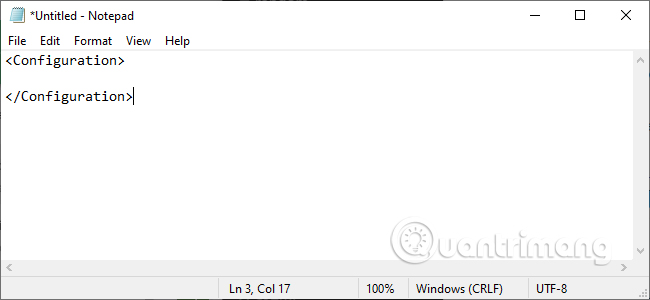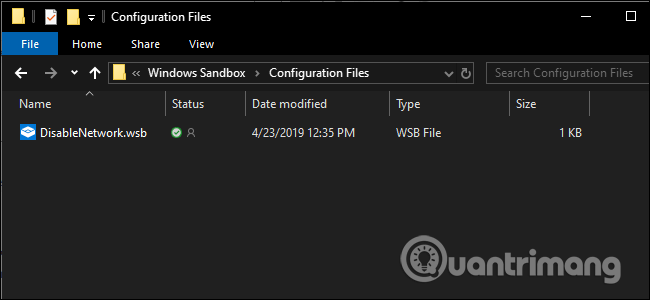How to configure Windows Sandbox on Windows 10
The new Sandbox feature of Windows 10 lets you safely test programs and files downloaded from the Internet by running them in a safe environment. This feature is very easy to use but its settings are hidden in the text configuration file. This article will show you how to configure Windows Sandbox on Windows 10.
- Run untrusted .exe files: Use Windows Sandbox
- 7 best Sandbox apps for Windows 10
- What is a sandbox and how does it sandbox a program?
This feature is part of the May 2019 Update of Windows 10 update. Once the update is installed, you can use it on Professional, Enterprise or Education versions of Windows 10. But if it is available on the system You can easily activate the Sandbox feature and then launch it from the Start menu.
The sandbox will launch, copy the current Windows operating system, access the private folder, bring you a clean Windows desktop with Internet access. Before Microsoft adds this configuration file, you cannot customize the Sandbox. If you do not want to access the Internet, you must disable it immediately after launching. If you need to access the file on the host system, you must copy and paste them into the Sandbox. And if you want to install a specific third-party program, you must install them after launching the Sandbox.
Because Windows Sandbox deletes its entire instance when closed to make the system more secure, you must perform a custom process each time it is launched. If a problem occurs, close the Sandbox and everything will be deleted.
How to configure Windows Sandbox

This tutorial assumes you have set up Sandbox for normal use. If not, you need to enable it first with the Windows Features dialog box.
To get started, you need to use the Notepad application or other text editing application. You need to create an XML file to configure. Once you've created the file you need to save it with the .wsb extension, then double-click the file that will launch the Sandbox with a specific configuration.
As explained by Microsoft, you should choose some options when configuring Sandbox such as enabling or disabling vGPU (virtual GPU) turning on or off the network, defining shared host directory, setting read / write permissions on the message item or run the script at launch.
Using this configuration file will allow you to disable the virtual GPU (it turns on by default), turn off the network (turned on by default), specify the shared host directory (the sandbox application does not have access to This directory is by default), set read / write permissions on that directory and run the script at launch.
First, open Notepad or your favorite text editing application and add the following line to the new text file:
All the options you add must be between these two parameters. You can add one or more options or if nothing else, it will use the default configuration.

How to disable virtual GPU or network
According to Microsoft, turning on a network or virtual GPU will increase the likelihood of malware coming out of the sandbox environment, so if you need to test something suspicious of malware, you should disable it.
To disable the virtual GPU (enabled by default) add the following line of text to the configuration file.
Disable

To disable network network access (turned on by default) add the following line of text:
Disable

How to map directories
To map the directory you need to specify the folder to share and then specify which directory to read only.
Perform directory mapping using text lines similar to the following:
C: UsersPublicDownloads
true
HostFolder is where you list the specific folder you want to share. In the above example, the Public Download folder in the Windows system is shared. ReadOnly sets the ability of the Sandbox to write a directory with true value only to read or false to write.
However, you need to be aware that your system may be at risk when linking folders between Windows Sandbox with storage and the granting of write permissions increases this danger. If testing something that is suspected to be malicious, you should not use this option.
How to run the script at launch
Finally, you can run the custom script or the basic command to force the Sandbox to open the mapped folder at launch. Replace the directory path and grant the correct permissions for your directory.
C: UsersPublicDownloads
trueexplorer.exe C: usersWDAGUtilityAccountDesktopDownloads
WDAGUtilityAccount is the default user of Windows Sandbox, so you need to view it as part of the command when opening a folder or file.
However, in the recently released build of Windows 10's May 2019 update, the LogonCommand option does not work, it does not take any action. Hopefully Microsoft will soon fix this error

How to launch Sandbox in Settings
After editing the configuration file, save it in .wsb format. For example, if your text editing application saves the file as Sandbox.txt, fix it to Sandbox.wsb. To launch Windows Sandbox in the installation, double-click the .wsb file. You can leave this file on the desktop or create a shortcut in the Start menu.
- Create and customize application shortcuts on win 10

I wish you all success!
You should read it
- How to turn on / off Windows Sandbox on Windows 10
- What is a sandbox and how does it sandbox a program?
- What is a sandbox? The best Sandbox software
- 7 best Sandbox apps for Windows 10
- Activate Windows Sandbox on Windows 10 to run the unreliable .exe file
- How to enable sandbox feature on Windows Defender
- How to enable / disable video input in Windows Sandbox on Windows 10
- Instructions on how to use Windows Sandbox on Windows 10
May be interested
- How to fix the problem of missing the Sandbox feature after updating Windows 10 May 2019
 after updating windows 10 may 2019 (1903), many users reported that windows sandbox could not be found, here is how to fix this problem.
after updating windows 10 may 2019 (1903), many users reported that windows sandbox could not be found, here is how to fix this problem. - How to enable / disable video input in Windows Sandbox on Windows 10
 windows sandbox provides a lightweight desktop environment to safely run applications. this tutorial will show you how to enable or disable video input in windows sandbox for all users in windows 10.
windows sandbox provides a lightweight desktop environment to safely run applications. this tutorial will show you how to enable or disable video input in windows sandbox for all users in windows 10. - Windows Sandbox: The Secret App That Lets You Open Anything Without Risk
 using this tool, you can safely check suspicious files, install suspicious software, or browse dangerous websites without risking damage to your main computer.
using this tool, you can safely check suspicious files, install suspicious software, or browse dangerous websites without risking damage to your main computer. - How to fix Windows Sandbox error 'No Hypervisor Was Found 0XC0351000'
 windows sandbox is a handy utility to check for untrusted applications and files in a secure virtual environment. the setup process is pretty straightforward for windows sandbox.
windows sandbox is a handy utility to check for untrusted applications and files in a secure virtual environment. the setup process is pretty straightforward for windows sandbox. - 7 ways to fix 'Windows Sandbox Failed to Start' error
 the windows sandbox tool acts as a temporary virtual desktop environment. however, while trying to use this tool, you may get a 'windows sandbox failed to start' error.
the windows sandbox tool acts as a temporary virtual desktop environment. however, while trying to use this tool, you may get a 'windows sandbox failed to start' error. - 3 Best Windows Sandbox Alternatives for Windows 11 Home
 these alternatives allow you to test untrusted programs and browse the web safely like what windows sandbox offers.
these alternatives allow you to test untrusted programs and browse the web safely like what windows sandbox offers. - Microsoft released Windows 10 Insider Preview Build 18353, focusing on Sandbox improvements
 microsoft recently released preview build 18353 (19h1) for windows 10 insider users on fast ring. specifically, this release will mainly focus on bug fixes, along with a few notable improvements to windows sandbox.
microsoft recently released preview build 18353 (19h1) for windows 10 insider users on fast ring. specifically, this release will mainly focus on bug fixes, along with a few notable improvements to windows sandbox. - Secedit: configure command in Windows
 secedit: configure command allows you to configure the current system settings using the security settings stored in the database.
secedit: configure command allows you to configure the current system settings using the security settings stored in the database. - Protect your computer with Sandbox
 if viruses and malware are common problems or merely users worry that your antivirus program is not enough, you can add a few layers of protection to your computer by installing the sandbox application. one episode
if viruses and malware are common problems or merely users worry that your antivirus program is not enough, you can add a few layers of protection to your computer by installing the sandbox application. one episode - How to use Shelter to sandbox apps on Android
 shelter is a very convenient android security app that allows you to place apps in a sandbox. in the article below, tipsmake will talk about how shelter works and how to use this tool.
shelter is a very convenient android security app that allows you to place apps in a sandbox. in the article below, tipsmake will talk about how shelter works and how to use this tool.










 How to add colors to Windows 10
How to add colors to Windows 10 How to install the virtual assistant Google Assistant on a Windows computer
How to install the virtual assistant Google Assistant on a Windows computer Still using Windows 7? This is the reason security should upgrade to Windows 10
Still using Windows 7? This is the reason security should upgrade to Windows 10 How to map WebDAV drives in Windows 10
How to map WebDAV drives in Windows 10 How to hide Favorites Bar in Chromium Edge on Windows 10
How to hide Favorites Bar in Chromium Edge on Windows 10 What is Windows 10 IoT? And when do you use it?
What is Windows 10 IoT? And when do you use it?